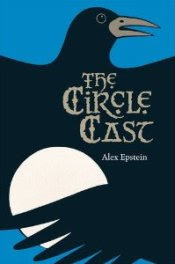As Arthurian buffs will know, Morgan is the daughter of Ygraine by her first marriage to Gorlois, Duke of Cornwall. Depending on which version you follow, she is either sent away to a nunnery or married off to a northern lord after Uther Pendragon kills her father. Or both of these, consecutively. Later, she becomes a sorceress who plots against Queen Guinevere and whose dark powers stir up trouble at her half-brother's court at Camelot.
Alex Epstein's The Circle Cast, a novel of her lost teenage years, forces us to re-imagine her character and role in the mythos by calling her something else.
His heroine, Anna of Din Tagell, is a girl of eleven when her life is shattered. Although it uses the legend as a springboard, this story is firmly situated in early medieval Britain, with Saxons preparing to attack, Uter Pendragon rallying the British as war leader, and Gorlois acting in the role of Roman provincial governor despite the Romans' departure from the island a century earlier.
Uter and Gorlois are allies at first. But when Gorlois gets wind of Uter's advances toward Ygraine, he breaks his oath to Uter and leaves... which causes Uter to come after him. Though still a child, Anna can sense enough magic to detect the glamor that the Enchanter casts on Uter and his men, the one that leads to Uter's seduction of Ygraine, the murder of Gorlois, and, nine months later, the birth of Arthur. (The Enchanter isn't called by name; names, as we learn, are important.) Anna is also puzzled at Ygraine's choice not to complete the magic circle that would have invoked the war goddess Morigenos in the defense of Din Tagell.
To keep her safe from Uter, Ygraine sends Anna away to Ireland, where her cousin Queen Ciarnat rules, and gives her a new name for her protection: Morgan, sea-born, "a darker, redder name than the name the wind had taken." Over the next number of years (either four or ten... the story contradicts itself in places), Anna/Morgan is forced to reinvent herself in other ways. Her plan for revenge against Uter takes root in this foreign land and sustains her during her travails. She becomes the slave of a pagan wise-woman, a scribe and teacher in a Christian settlement, and, finally, the wife of an Irish chieftain, Conall.
Wherever Morgan ends up, her scenes are rendered with a lyrical simplicity. The prose can read like that of a young adult novel, although some of the themes are geared more towards adults.
The story loses some focus the longer Morgan stays in Ireland, and Morgan, it seems, feels this too. She doesn't want to lose her ties to the land and its power, and she needs to see her mission through. Despite her strong affections for Conall, her role as his wife is getting in her way. What follows next is a vigorous yet heartbreaking tale about the value and price of vengeance.
The Circle Cast should add to the intrigue surrounding this complex Arthurian figure. Morgan's decisions may or may not be the reader's, but she stays true to herself regardless of the sacrifice.
The timing of this post is accidental, but as long as we're here: for those who don't especially care about the Arthurian connection, The Circle Cast also offers a sweeping picture of 5th-century Ireland, a place of woods and green meadows, warring clans, ancient pagan rites, and a young, new Christianity that inspires fierce devotion in its followers. There's plenty of ale and good storytelling to go 'round, too. Sláinte.
The Circle Cast was published by Tradewind Books in 2011 at $12.95 (trade paperback, 300pp), same price in the US and Canada.







I LoVE Morgan La Fey, I think she is one of the most underrated characters in Arthurian mythology :) This book sounds really cool, I think I'll check it out
ReplyDelete-Kate the Book Buff
Recent Post: Betcha Didn't Know: Harry Potter Edition
Morgan is a great character. That's one reason I loved Mists of Avalon. She's entirely different here, but it's still in keeping with the legend.
ReplyDelete